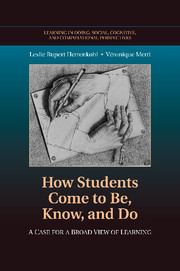Book contents
- Frontmatter
- Contents
- Series Foreword
- Acknowledgments
- How Students Come to Be, Know, and Do
- Introduction
- 1 The Context Lens
- 2 How Ways of Knowing, Doing, and Being Emerged in the Classroom: Interpersonal Interactions and the Creation of Community, Part I
- 3 How Ways of Knowing, Doing, and Being Emerged in the Classroom: Interpersonal Interactions and the Creation of Community, Part II
- 4 Personal Lens of Analysis: Individual Learning Trajectories
- Conclusion
- References
- Index
- Titles in the series
2 - How Ways of Knowing, Doing, and Being Emerged in the Classroom: Interpersonal Interactions and the Creation of Community, Part I
Published online by Cambridge University Press: 06 December 2010
- Frontmatter
- Contents
- Series Foreword
- Acknowledgments
- How Students Come to Be, Know, and Do
- Introduction
- 1 The Context Lens
- 2 How Ways of Knowing, Doing, and Being Emerged in the Classroom: Interpersonal Interactions and the Creation of Community, Part I
- 3 How Ways of Knowing, Doing, and Being Emerged in the Classroom: Interpersonal Interactions and the Creation of Community, Part II
- 4 Personal Lens of Analysis: Individual Learning Trajectories
- Conclusion
- References
- Index
- Titles in the series
Summary
Educational research has demonstrated that educational designs can be quite different from their enactment. Therefore, designed principles and practices must be considered in emergent terms. Even though the designed features for this study were linked to observations made by teachers and researchers in the school, until they were placed into actual classrooms they existed only as models that may remedy some classroom dilemmas. Using a design-experiment approach (Brown, 1992), Leslie and Mrs. Glenda decided to see what would happen if new tools and strategies were introduced in the classroom. Leslie put significant thought into classroom participation structures and tools that could help students better understand the science and take more responsibility for questioning one another about the their ideas in science. Leslie and Mrs. Glenda did not plan for possible challenges the students would face as they navigated new ways of being that were associated with these new ways of knowing. What happened when Mrs. Glenda set the designed values, principles, and practices described in Chapter 1 with the students as key members of the community? How did new ways of being come together with new ways of knowing in the context of the classroom?
In this chapter and Chapter 3, we focus on interpersonal interactions as they unfolded and created a classroom community where students questioned each other about their scientific ideas. In this chapter we focus on how students took up their new roles as “questioners.”
- Type
- Chapter
- Information
- How Students Come to Be, Know, and DoA Case for a Broad View of Learning, pp. 45 - 101Publisher: Cambridge University PressPrint publication year: 2010

